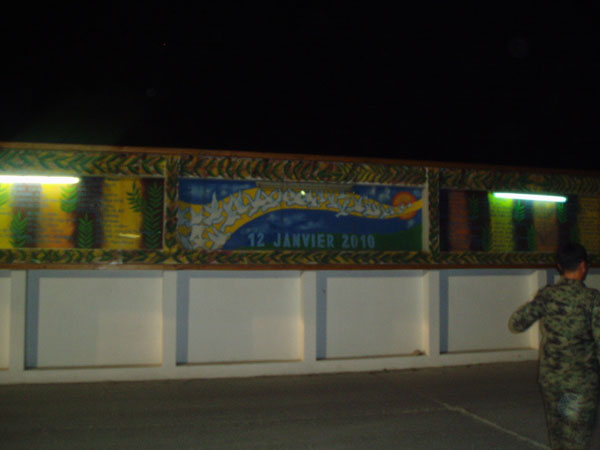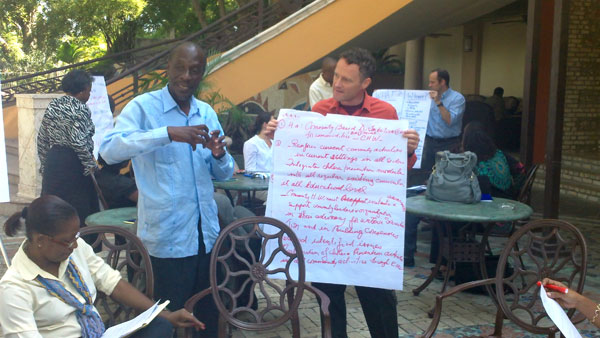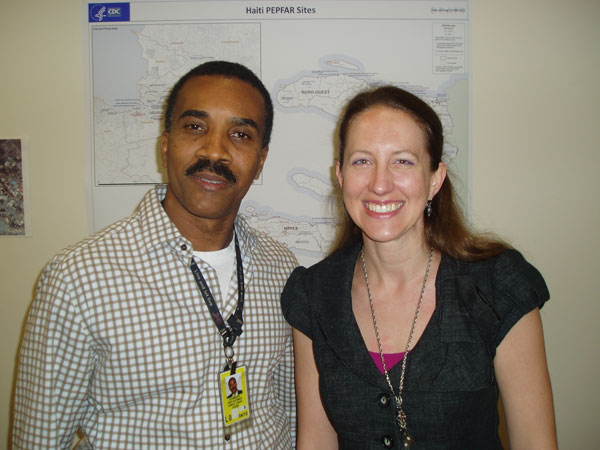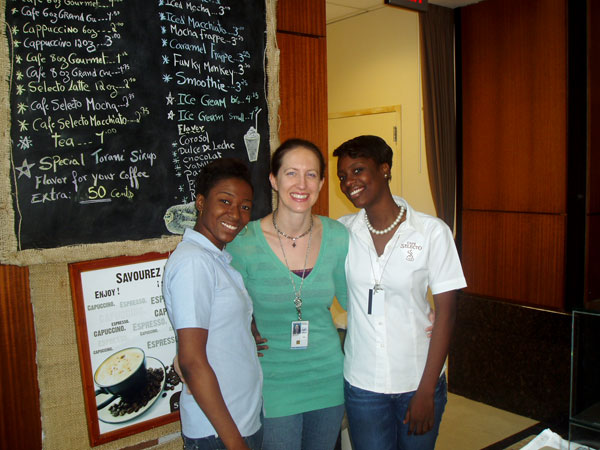Haiti Cholera Response: Stories from the Field, Part 3
Posted on by
On one beautiful sunny day, we passed by a group of people under an awning. At first, I thought they might be gathering after a church service. Only as we passed did I realize they sat facing a coffin. Fifteen minutes after passing this congregation, we came upon another group of people dressed in white and black. It was a procession carrying yet another coffin through the dusty streets.
At every clinic we visited, we asked what supplies were needed. At every clinic, one of the answers was “more body bags.” [View our Photo and Video Galleries]
Previous Experience in Haiti
I lived and worked in Haiti in 2008 as part of my Masters of Public Health program. I discovered that Haitians are incredibly generous and hospitable, and always quick to smile. After work, I would spend long hours with my new friends, sipping coffee with cane sugar and listening to their hilarious anecdotes, which they acted out with outrageous facial expressions and gestures. However, despite their quick smiles and ready laughs, I knew life in Haiti was difficult.
Malnutrition, poor sanitation, and infectious disease ran rampant. Infant mortality was a fact of life. I worked with community health workers who had to walk six hours from their village to a road, and then ride public transportation for four more hours, just to reach a primary health clinic. That an earthquake, cholera, and hurricane could further devastate such fragile lives was almost unthinkable.
Rainbows Can Be Misleading
As a CDC Health Communications Specialist in the Emergency Risk Communication Branch, my day job is to ensure that CDC’s audiences receive information that is timely, accessible, and accurate. Health communications is a mostly unseen role, but it allows CDC to translate complicated scientific messages into easy-to-understand English, and other languages. This is especially important during an emergency.
I was recently deployed to Haiti twice as part of CDC’s Haiti cholera outbreak response. The first time I was deployed was less than two weeks after I started my new job at CDC. In fact, I took the photo for my official government passport only four hours after sitting for the photo for my official employee ID.
I arrived in Port-au-Prince for my first deployment on October 29, 2010. The Haitian countryside, especially when seen from an airplane, is breathtaking. Verdant mountains push up into a brilliant blue sky, with the ocean sparkling in the distance. From up high, it is difficult to believe this beautiful island could endure such heartache.
[youtube width=”560″ height=”349″]http://www.youtube.com/watch?v=7TkzqNUpH-A[/youtube]
By the time I arrived at the American embassy, where I would be living and working, a rainbow stretched halfway up the sky like a good omen. My optimistic mood was broken, however, as I walked into the daily staff meeting for the CDC cholera response. About 20 somber, tired, overwhelmed employees greeted me, and gave brief updates on the activities they had performed that day. This began two weeks of long hours at a breakneck pace, filled with constant stress. We worked as fast as we could to implement activities that would slow, if not stop, the impact of cholera. Sometimes it felt as though I accomplished more in one day of work in Haiti than I could in an entire week back in Atlanta. We worked on a training-of-trainers for clinicians, so that doctors and nurses would know how to diagnose and treat cholera.
The Number of Sick and Dead Grew
We tried to improve surveillance systems and make sure supplies got to the clinics and treatment centers that needed those most. Still, at every staff meeting, the number of sick and dead grew. To think about what those numbers really mean, that each digit is one more person, with a life and a family, who has died from a largely preventable disease, is simply too much to bear. I went on a surveillance mission to Artibonite, where the cholera outbreak began, to lend my French translation skills. We visited cholera treatment centers, where we saw men, women, and children lying limp and motionless on cots, surrounded by worried family.

Then Hurricane Tomas threatened Haiti. Luckily, Tomas passed further to the west than anticipated. I left Haiti just before the Clinical Management Training-of-Trainers took place. The instant I arrived back in Atlanta, I began telling anyone who would listen that I wanted to go back to Haiti.
From Emergency Response to Long-Term Planning
On my second deployment from January 25, 2011 to February 15th, I came better prepared, with enough sugar and caffeine to keep me awake long into the night. However, when I arrived on Saturday evening, I was greeted not by somber faces, but by an invitation (no, an insistence) that I join in a volleyball game. CDC employees were still putting in long hours at the office, but could no longer sustain the crazy, breakneck speed from October. We needed to take moments to rest and recharge, knowing that the cholera response, like the earthquake response, would stretch long into the future.
We had moved from emergency response, with its high adrenaline and short timelines, to long-term planning for sustainable projects. It was time to pause, carefully consider strategies, and plan for the future. I attended a day-long meeting with USAID and U.S. government partners to discuss a unified strategy moving forward. We began making the shift from treating cholera as an emergency situation to treating it as another diarrheal disease, like the many that already affect Haiti.
Back at the CDC-Haiti Office
Back at the CDC-Haiti office, our needs had also shifted. During my first deployment, my motto was “Do not let the perfect be the enemy of the good.” Communication and education materials needed to be developed and distributed as soon as humanly possible, so we could work to save as many lives as we could in a short period of time. The materials did not have to be perfect; they just had to be good enough to get across the right messages. Now, however, I found myself repeatedly telling my colleagues that it is better to take extra time to develop a superior product that can be used for years to come, rather than immediately distributing a product that was simply good enough.
My final project was to create a library of all the communication and education materials about cholera CDC has developed. This will ensure that the CDC staff in Haiti will have materials at their fingertips to use now or at any point in the future. It is amazing to see the large quantity and wide range of CDC’s work, and to know CDC continues to create new materials to meet the needs of Haiti’s population.
Life Must Go On
The weather was again sunny and gorgeous as I was driven to the airport to leave. Children dressed in freshly laundered school uniforms, the girls with matching ribbons in their hair, laughed and jostled each other in the street. A woman walked to the market, balancing a large basket of live chickens on her head. Nightclubs advertised live compa music on Friday evenings. Haitian people have lived through so many tragedies, but still, life must go on.
I only hope that when I visit Haiti again, it will be to drink coffee with my Haitian friends and colleagues, and not because yet another public health disaster is testing Haiti’s resilience again.
Please feel free to send me a comment or ask a question about my Haiti deployments.
Photo Gallery
4 comments on “Haiti Cholera Response: Stories from the Field, Part 3”
Comments listed below are posted by individuals not associated with CDC, unless otherwise stated. These comments do not represent the official views of CDC, and CDC does not guarantee that any information posted by individuals on this site is correct, and disclaims any liability for any loss or damage resulting from reliance on any such information. Read more about our comment policy ».










Thank You Molly for sharing about your incredible experiences during your trip. The mental picture you created of the families around coffins, provides an understanding of just how devastating a treatable disease can be when it overwhelms the resources of a region. May your future trips to Haiti be filled with coffee, sugar cane, and volleyball!
Thank You for sharing about your experiences whit us.
Thanks for sharing your wonderful and unforgettable experience.
Great to see you are helping Haiti! Great job with the blog! Thanks for sharing the post!